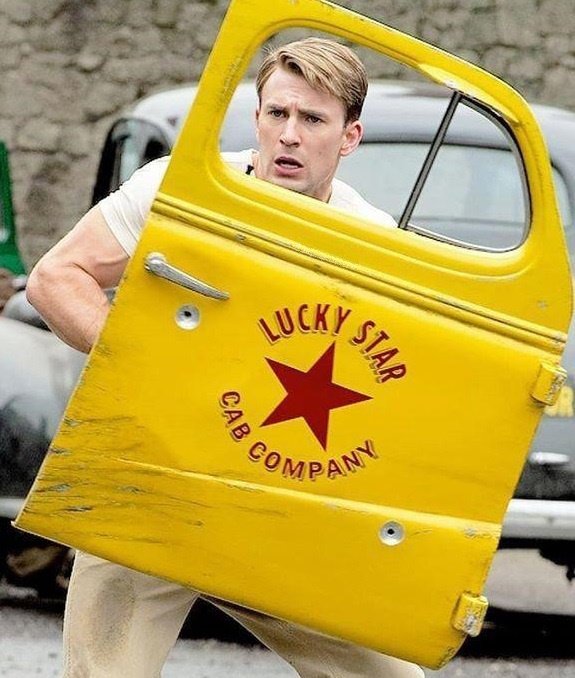Rules Analysis of an MCU Scene: Cap picks up the taxi door in First Avenger
After a thrilling chase through the streets of Brooklyn, Steve Rogers finally catches up with Doctor Erskine’s assassin. He leaps onto the roof of the Lucky Star taxi that the Hydra Agent commandeered, and while blindly shooting through the roof of the vehicle, the assassin loses control of the cab. It flips over several times, and the door flies off. Stunned, but alive, the assassin escapes from the wreck, stands, and points his gun at Steve. Our hero sees the yellow car door lying in front of him, picks it up, and ducks behind it, stopping two bullets from ending his career as Captain America before it even started.
This is such a great moment. Not only are Steve’s bravery and relentlessness on full display - attributes he had in spades before he got the Super Soldier Serum - but the star in the middle of the door foreshadows things to come later in the movie when he gets his Vibranium shield from Howard Stark. Iconic scenes like this one can be created at your gaming table, as well! Let’s explore how you as a Narrator can use the rules of the Marvel Multiverse RPG to create similar scenes at your own gaming table. Let’s get into the details!
For the purposes of this exploration, let’s assume that Cap doesn’t yet have his “Shield Bearer” powers, as he’s never picked up a shield before (the garbage can lid earlier in the movie doesn’t count!). Looking at how many of his Powers come from Shield Bearer, you could make the case he’s Rank 2 at this point. That’s in line with another strong but inexperienced character from the Cataclysm of Kang book, Demolisher from the Wrecking Crew. Feels about right.
When translating the cinematic action to the game system rules, we’re met with an immediate challenge - there’s no action for taking cover. That’s okay, we can houserule it. We obviously have lots of rules for using a shield, so if we’re going to houserule how a hero might “take cover”, we need to ensure it is not as powerful as the “Shield Bearer” Powers on Page 117 of the Core Rulebook.
“Shield 1” provides Health Damage Reduction of 1 as a Reaction or a Standard Action.
“Shield Deflection” applies Trouble to an incoming attack as a Reaction.
“Shield Wall” also applies Trouble, but as a movement action.
All of those abilities allow a character to attack in the same round as they’re taking cover. A great way to balance a “Take Cover” action for non-Shield Bearers would be to make it a Standard Action, meaning a hero can just defend that turn. For consistency’s sake, lets word this house rule similarly to the Dodge Standard Action on page 30 of the Core Rulebook.
Take Cover (Standard Action): The character actively seeks protection from incoming attacks. The character can apply a Health Damage Resistance of +1 to any incoming attacks until the character’s next turn. The character must have previously used a move action to either raise a suitable barrier (of their Size or one Size smaller), or to have moved behind such a barrier (such as a low wall or a public city mailbox. The Narrator has final say of what a “suitable” barrier is, and whether it can provide Health Damage Resistance against a given incoming attack.
Something to keep in mind - if a player moves behind a piece of terrain that completely shields them from view, they are no longer a valid target (see page 30 of the Core Rulebook: “For a ranged attack, the target must be within the attacker’s line of sight”).
I think the houseruled “Take Cover” approach works nicely with the scene. In the movie, after Steve drops the door to chase after his foe, he grabs at his ribcage, and you can see some shrapnel from the bullet has grazed his side - telling us that the attack was not completely avoided, but the damage was reduced. Also, Steve was ducking behind the door for a few seconds - enough time for the Hydra Agent to run to the crowd and take a hostage. Only then does Steve move out from behind the cover of the door. Definitely a standard action there! Validation!
Hope you had some nerdy fun deconstructing this scene with me, to see how it might work on the tabletop. For me, this wasn’t only a way to gain a better understanding of the rules, but it also reminded me of ways I can make my tabletop battles more cinematic and memorable. Do you have a suggestion for another scene deconstruction? Or ideas for a different kind of article? Please leave a comment!
